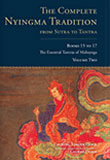
“The essence of Mahāyoga is that liberation is obtained through union with the indivisible superior truth (lhag pa’i gnyis med bden pa) by relying emphatically on the generation stage of meditation in which skillful means is employed (thabs kyi bskyed rim). The Sanskrit term mahāyoga is defined as the “great union” of the mind with nondual truth. The classification includes the following topics of empowerment (dbang bskur) and engagement (’jug pa), view (lta ba), discipline (tshul khrims), meditation (sgom), conduct (spyod pa), and result (’bras bu). Once the empowerments of beneficence, ability, and profundity have been conferred, the practice of Mahāyoga is engaged through three successive phases of meditative stability, namely, great emptiness (stong pa chen po), which purifies death; great compassion (snying rje chen po), which purifies the intermediate state after death; and the seals and attainment of the maṇḍala clusters (phyag rgya dang tshom bu tshogs sgrub), which purify the three phases of life by establishing the practitioner’s true nature to be the assembly of deities. The view maintained by Mahāyoga practitioners holds ultimate truth (don dam bden pa) to be spontaneous awareness without conceptual elaboration, relative truth (kun rdzob bden pa) to comprise the ideas or mental energy of that awareness manifesting as buddha body and pristine cognition, and the superior indivisible truth to be the unity of these two—emptiness and pure appearance. Discipline in the context of Mahāyoga refers to specific commitments that are upheld in relation to meditative practice, renunciation, and attainment. Meditation comprises both nonsymbolic meditative stability in the nature of ultimate reality and the symbolic meditations of the generation and perfection stages. In the generation stage, the meditational deities are gradually visualized through the aforementioned meditative stabilities, in which deity and thought processes are indivisible. In the perfection stage, the visualization then emphasizes the control of the energy channels, winds, and vital essences, either within the meditator’s own subtle body (rang lus steng sgo) or else when in union with a yogic partner (gzhan lus ’og sgo). The conduct observed by practitioners of Mahāyoga implies that the defilements and afflictive mental states of cyclic existence, as well as the rites of liberation (sgrol) and union (sbyor), can be engaged without attachment because they are retained as skillful means. Lastly, the result attained by practitioners of Mahāyoga is the actualization of the five buddha bodies in this very lifetime or in the intermediate state after death.”
—Excerpt from the translator’s introduction (page xliii) to The Complete Nyingma Tradition from Sutra to Tantra, Books 15 to 17, The Essential Tantras of Mahayoga, Choying Tobden Dorje, translated by Gyurme Dorje.


